Have you ever wondered how to turn your living room into a peaceful retreat that combines simplicity with elegance? Japandi interiors have taken the design world by storm, offering a perfect blend of Japanese minimalism and Scandinavian coziness. Their popularity lies in creating calming spaces that promote mindfulness and relaxation, all while maintaining a sleek, modern aesthetic.
It’s no wonder so many are drawn to this style—it’s a sanctuary for those seeking balance in a busy world. In this article, you’ll discover a wealth of inspiring ideas and practical tips to craft your ideal Japandi living room.
From choosing the right neutral color palettes to incorporating natural materials and clever storage solutions, these suggestions will help you achieve a serene, clutter-free environment. Whether you’re starting fresh or refreshing your current space, get ready to explore a variety of design concepts that embrace tranquility, functionality, and timeless beauty.
Creating a tranquil Japandi living room begins with selecting a soothing, neutral color palette that promotes serenity and clarity. Soft beiges, warm greys, muted taupes, and gentle creams serve as the perfect foundation, allowing the space to feel open and inviting.
These tones reflect natural light beautifully and help avoid visual clutter, making the room feel more expansive and peaceful. The goal is to craft a harmonious environment where every element complements the overall calm aesthetic.
Visualize walking into a room painted in a warm, sandy beige with subtle variations in texture, accented by light grey cushions and a creamy woven rug. The furniture features matte finishes in soft, natural hues, with surfaces that feel smooth and inviting.
Accents like a light taupe throw blanket or a muted stone-colored vase enhance the layered, minimalist look. The overall effect is a space that feels airy, balanced, and free of distraction, allowing your mind to relax fully.
To recreate this calming palette, start by choosing paint colors in gentle neutral shades—think of soft shades of white, taupe, or grey. Incorporate textiles like linen cushions or throws in matching tones, and select furniture with matte or wood finishes in similar hues.
Keep decorative accents minimal and cohesive to maintain the simplicity. Using natural light to highlight these colors will amplify the sense of calm, turning your living room into a sanctuary of serenity.
2. Incorporate Low-Profile, Minimalist Furniture
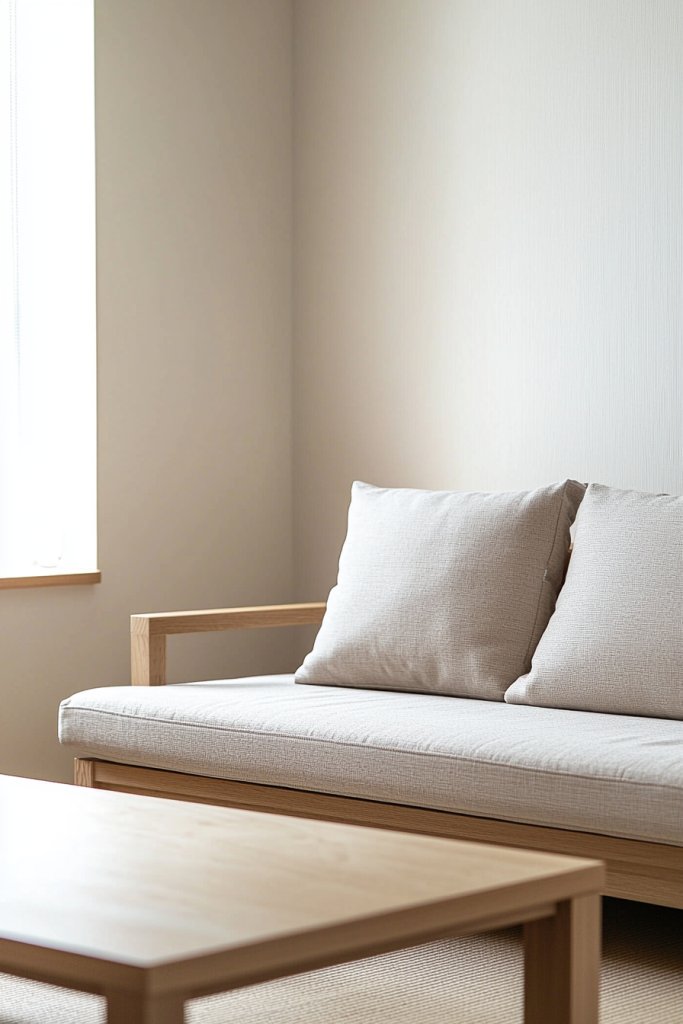
A key element of Japandi style is furniture that sits low to the ground, emphasizing simplicity and spaciousness. Think of sleek, streamlined sofas with clean lines, and coffee tables with minimalist frames in natural woods or matte finishes.
These pieces foster an open, uncluttered environment that invites relaxation and promotes an effortless flow throughout the room. Imagine a low, plush sofa in a soft beige or light grey, paired with a rectangular coffee table made of smooth, light oak.
The furniture’s proportions are understated, with slender legs and simple shapes that don’t dominate the space. This arrangement encourages a sense of openness, with plenty of room to breathe.
The textures are tactile but subtle—think smooth wood, soft cushions, and sleek metal accents—creating a harmonious balance between comfort and minimalism. Getting started is easy: choose furniture with low profiles—sofa heights around 16-18 inches—and avoid overly bulky designs.
Opt for pieces with clean, unadorned lines and natural materials like light wood or matte metal. Keep accessories minimal—perhaps a single, simple side table or a few cushions—to prevent visual clutter. Focus on quality and craftsmanship, selecting versatile pieces that will stand the test of time and fit seamlessly into your serene living space.
3. Use Natural Materials for a Warm, Textured Look
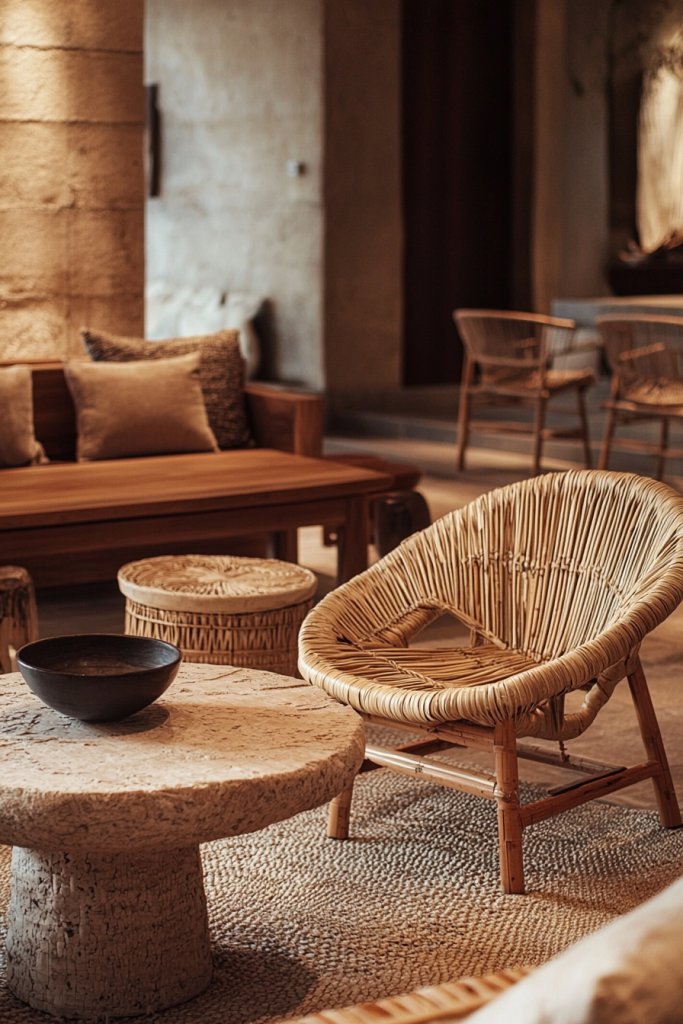
In Japandi interiors, natural materials are the cornerstone of warmth and tactile richness. Incorporate wood, bamboo, rattan, and stone into your furniture, accents, and decor to evoke a deep connection with nature.
These elements add subtle textures and organic beauty, transforming a minimalist space into one that feels inviting and grounded. Picture a living room with a light oak or ashwood coffee table, complemented by woven rattan baskets and bamboo side accents.
The furniture’s grain and texture invite touch, while the natural scent of wood and fibers enhances the sensory experience. Rattan cushions, a woven jute rug, and ceramic vases with earthy tones subtly emphasize the organic theme.
This combination creates a space that is warm, textured, and full of natural character. To incorporate these materials, start with essential pieces like a wooden coffee table or rattan storage baskets.
Use textiles such as linen or jute for cushions and rugs to add softness. When sourcing, look for sustainably harvested wood and natural fibers, or opt for affordable alternatives like bamboo or rattan. Keep the color palette neutral and earthy to maintain harmony, and focus on craftsmanship and authenticity to embody the Japandi ethos of mindful, natural living.
4. Add Soft, Layered Textiles for Comfort and Depth

Layering textiles is a simple yet powerful way to infuse comfort and visual depth into a Japandi living room. Think plush throws, linen cushions, and subtle area rugs that invite touch and create a cozy atmosphere without clutter.
These textiles soften the minimalist aesthetic while enhancing the tactile quality of the space. Envision a neutral-toned linen cushion set on a sleek sofa, topped with a chunky-knit throw in a warm beige.
Beneath a low-profile coffee table, a woven jute or wool rug adds texture and warmth underfoot. Soft, layered textiles in muted shades not only provide tactile comfort but also add depth, making the room feel inviting and layered without overwhelming the minimalist design.
The room softly absorbs sound, creating a peaceful environment. To achieve this look, select cushions and throws in natural fabrics like linen, wool, or cotton, in shades that complement your neutral palette.
Incorporate different textures—think smooth linen, chunky knits, and woven rugs—to add visual interest. Keep accessories minimal and thoughtfully placed—perhaps a single textured blanket draped over the sofa or a subtly patterned rug—to maintain balance. This approach makes your living space feel warm and lived-in, yet effortlessly serene.
5. Highlight Simplicity with Clutter-Free Surfaces
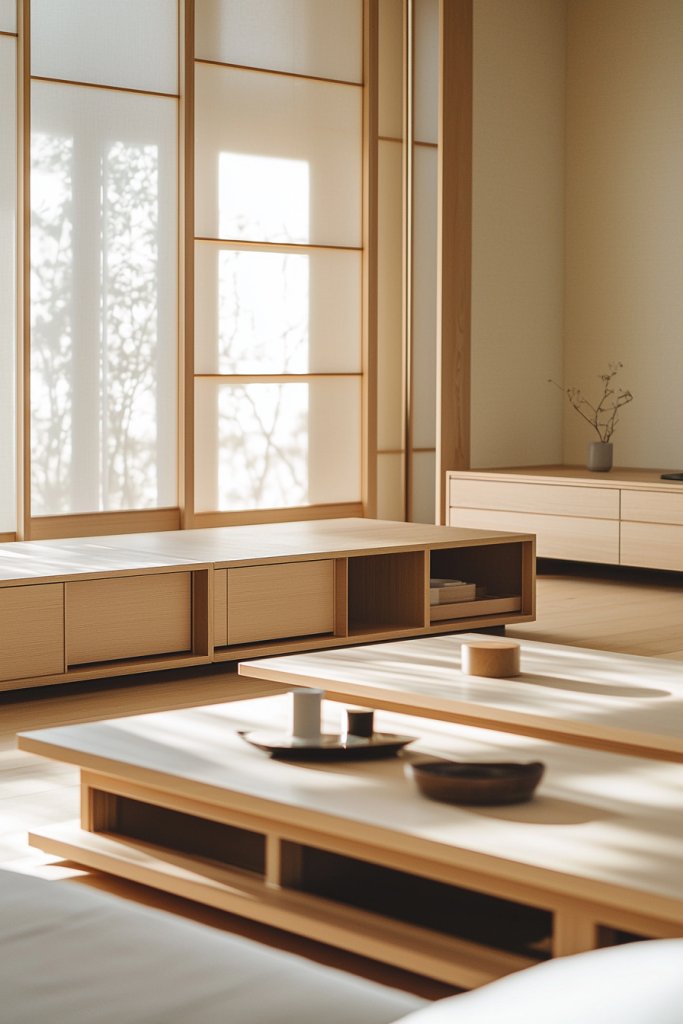
In Japandi design, less truly is more. Keeping surfaces free of clutter emphasizes the beauty of each piece and promotes a calm, organized environment.
Opt for furniture with hidden storage compartments or clean, flat surfaces, and limit decorative objects to only those that add purpose or quiet beauty. Picture a sleek, low sideboard with smooth fronts and no visible handles, holding only a few carefully chosen ceramics or a minimalist vase.
The coffee table remains clear, save for a single sculptural object or a small tray. Every surface feels intentional, with nothing to distract the eye.
This simple approach enhances the room’s sense of order, allowing light and space to flow freely, creating a peaceful, mindful ambiance. To implement this, choose furniture that offers concealed storage—like a sideboard with push-to-open doors or a coffee table with drawers.
Limit decorative items to a handful of meaningful objects, such as a ceramic bowl, a minimalist sculpture, or a small stack of books. Regularly declutter and organize to maintain the serenity. By prioritizing quality over quantity, your living room will feel calm, spacious, and truly reflective of the Japandi principle of mindful simplicity.
6. Incorporate Traditional Japandi Ceramics and Vases

Adding handcrafted ceramics and minimalist vases is a simple yet powerful way to infuse your living room with authentic Japandi charm. These pieces serve as both functional objects and subtle art, creating an understated focal point that emphasizes craftsmanship and simplicity.
When chosen thoughtfully, ceramics in muted tones like matte beige, soft grey, or earthy browns bring a calming, tactile presence to the space. Imagine a slim, elongated ceramic vase in stone-white sitting atop a low wooden sideboard, its smooth surface contrasting with the textured grains of the furniture.
A small, handcrafted bowl with a slightly uneven glaze can be a perfect centerpiece on your coffee table. These pieces often feature clean lines or subtle organic shapes, adding visual interest without overwhelming the serene aesthetic.
The tactile quality of the ceramics invites gentle touches, while their understated colors complement the neutral palette, creating a harmonious and calming environment. To incorporate these elements, start by sourcing handcrafted ceramics from local artisans or online shops specializing in Japanese-inspired wares.
Select a few key pieces—like a vase and a couple of bowls or planters—that can be displayed on shelves, side tables, or mantels. Keep clutter minimal by limiting decorative items, allowing each piece to stand out.
You can also mix textures by pairing matte ceramics with smooth, glazed finishes for added depth. With a little care, these ceramics will subtly elevate your living room’s aesthetic with timeless elegance.
7. Opt for Modern Scandinavian-Inspired Lighting

Lighting plays a crucial role in setting the tranquil, inviting atmosphere characteristic of Japandi interiors. Modern Scandinavian-inspired fixtures—such as sleek pendant lights, understated floor lamps, or lantern-style lamps—offer soft, warm illumination that enhances the calm mood.
These designs prioritize simplicity and functionality, often featuring clean lines, natural materials, and neutral hues. Picture a minimalist, black matte pendant hanging over your coffee table, casting a gentle glow that highlights the textures of your textiles and ceramics.
Alternatively, a simple wooden tripod floor lamp with a fabric shade can provide warm ambient light, making the space feel cozy and inviting. Lantern-style fixtures with subtle metal accents evoke a subtle nod to Japanese design principles, blending form and function seamlessly.
The lighting’s soft, diffused quality ensures the room feels peaceful, while the understated designs complement the overall aesthetic without overpowering it. To achieve this look, choose fixtures with minimalist silhouettes and neutral finishes like black, brushed nickel, or natural wood.
Many Scandinavian-inspired lights are easy to install and adjust, making them accessible for DIY projects. Position pendant lights over seating or dining areas, and use floor lamps in corners to balance the space.
When selecting bulbs, opt for warm white (2700K–3000K) LEDs to create a cozy, inviting glow. With a few carefully chosen fixtures, your living room will radiate serenity and understated elegance.
8. Use Modular and Multi-Functional Furniture Pieces
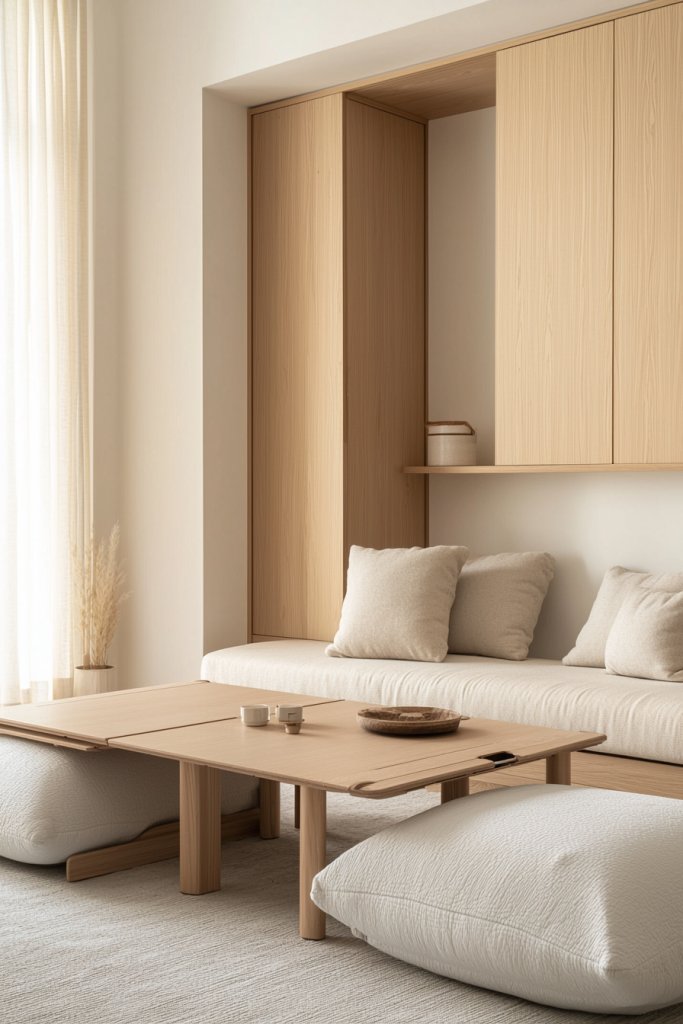
Maximizing space while maintaining a clean aesthetic is key to achieving a Japandi-inspired living room. Modular and multi-functional furniture—like fold-away tables, storage ottomans, or sofa beds—offer versatility and practicality without sacrificing style.
These pieces help keep clutter out of sight while contributing to the minimalist vibe. Visualize a sleek, low-profile sofa that doubles as storage with hidden compartments underneath, paired with a foldable wooden table that can expand for guests or fold flat when not in use.
A neutral-toned, woven storage ottoman can serve as both extra seating and a place to hide blankets or magazines, keeping surfaces tidy. These furniture choices emphasize clean lines and subtle textures, blending seamlessly into the calm, organized space.
Their adaptable nature allows the room to transition smoothly between everyday living and entertaining, enhancing both functionality and tranquility. To implement, start with core pieces like a multi-purpose coffee table or storage ottoman made from natural wood or neutral fabrics.
Look for designs that are easy to assemble or customize, and consider options with hidden storage to keep clutter minimal. When arranging, prioritize open pathways and avoid overcrowding — leave enough space around each piece for ease of movement and visual breathing room. This approach creates a flexible, serene environment that adapts effortlessly to your lifestyle while staying true to the Japandi aesthetic.
9. Integrate Textured Rugs for Visual Comfort
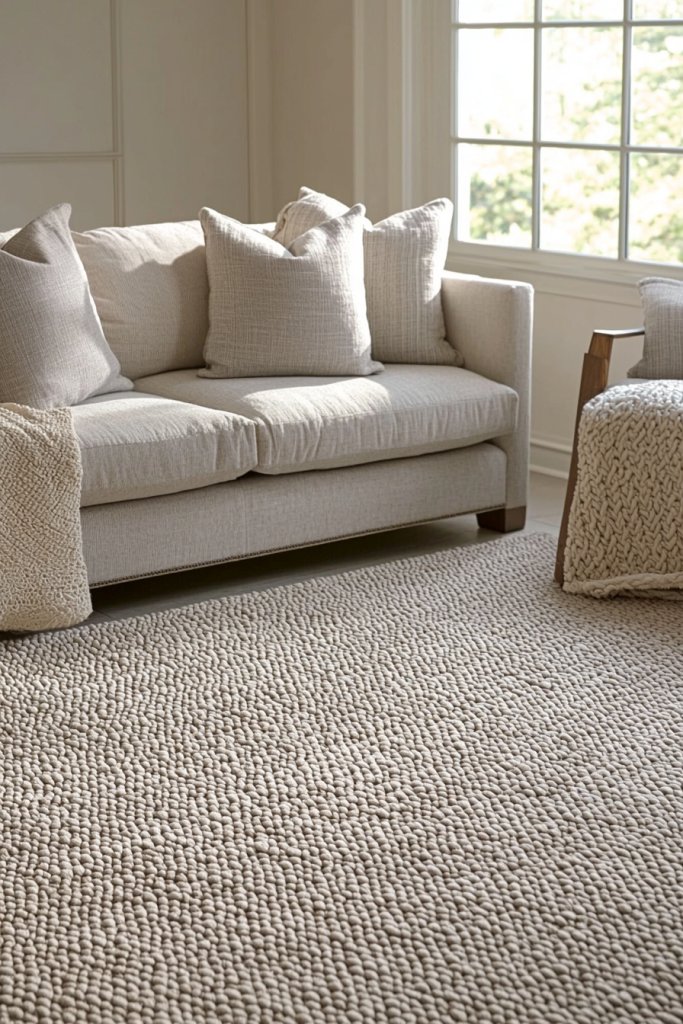
A textured rug anchors your living room’s design while adding warmth and subtle pattern. Flat-weave or woven rugs in neutral tones like soft beige, warm taupe, or muted grey help define zones within the space, creating a cozy yet uncluttered atmosphere.
Their tactile surface invites barefoot comfort and complements the natural materials used throughout Japandi interiors. Imagine walking into the room and feeling the gentle texture of a handwoven jute rug underfoot, its earthy fibers grounding the space.
The rug’s subtle pattern, perhaps a simple geometric or linear design, adds visual interest without disrupting the minimalist flow. Its neutral color palette ensures harmony with other elements, such as ceramics and textiles, while enhancing the room’s layered, inviting feel.
The visual softness and natural texture of these rugs make the space more approachable and soothing. To incorporate, choose a flat-weave or woven rug that fits your room’s size and layout.
Materials like jute, sisal, or wool are durable and eco-friendly options, and they can be sourced from home decor stores or online. For added versatility, layer a smaller, patterned textile on top for extra depth or warmth during colder months. With minimal effort, a textured rug transforms your living room into a warm, welcoming haven that embodies Japandi’s balance of simplicity and comfort.
10. Incorporate Sculptural Decor Elements
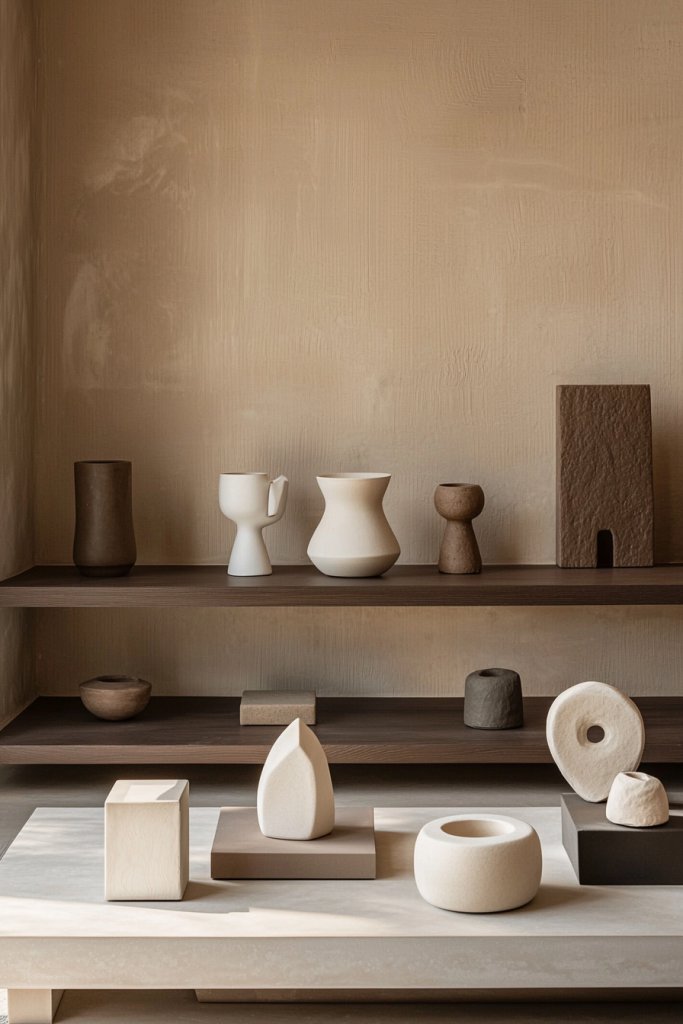
Adding sculptural decor pieces creates subtle focal points that elevate the minimalist aesthetic of a Japandi living room. Simple sculptures, abstract ceramics, or geometric objects serve as visual interest without cluttering the space.
Their clean lines and understated forms reflect the harmony between design and artistry that defines Japandi style. Picture a small, matte black abstract sculpture on a side table or a rounded ceramic orb on a shelf.
These objects bring a sense of purpose and artistry, subtly capturing attention without overwhelming the room. Their sculptural quality adds depth and texture to the decor, creating a layered visual experience.
The emphasis on simple, well-crafted objects aligns with the minimalist philosophy of “less is more,” making each piece meaningful and impactful. For implementation, select a few key decor objects that resonate with your aesthetic—think minimalist sculptures in neutral or matte finishes, or geometric ceramics in natural hues.
Place them thoughtfully on open surfaces like side tables, shelves, or mantels, avoiding overcrowding. Focus on quality over quantity; a well-chosen sculpture can serve as a quiet statement piece that enhances the room’s calm and sophisticated atmosphere. These elements subtly tie together the aesthetics of Japandi style, emphasizing mindful curation and understated elegance.
11. Maximize Natural Light with Sheer Drapes and Minimal Window Treatments
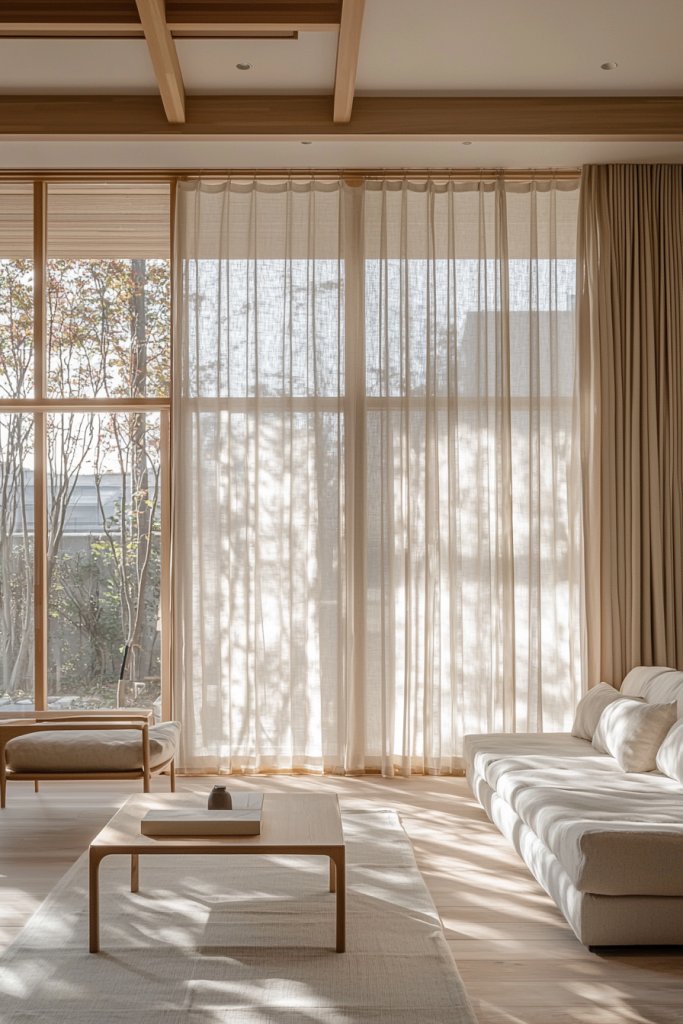
Harnessing natural light is essential to achieving the tranquil, airy feel characteristic of Japandi interiors. Bright, sunlit spaces not only elevate mood but also emphasize the simplicity and openness of the design.
Using sheer curtains or minimal window coverings allows sunlight to filter gently into the room, creating a warm, inviting glow that enhances the neutral color palette and natural materials. Imagine a living room bathed in soft daylight, with delicate, translucent curtains in a light cream or soft grey draped loosely to the side.
The sheer fabric moves gently with the breeze, casting subtle shadows and adding a sense of calm. The room’s light wood floors and minimalist furniture appear even more inviting under this natural illumination, highlighting textures like woven rugs and rattan accents.
The overall atmosphere feels fresh, open, and connected to the outdoors, fostering serenity and clarity. To achieve this look, opt for simple, lightweight curtains made from linen, cotton, or voile in neutral shades that complement your walls and furniture.
Keep window treatments minimal—consider roller blinds or no coverings at all—so that the focus remains on maximizing daylight. Ensure your windows are clean and unobstructed, and position furniture away from windows to avoid blocking light. This effortless approach transforms your living space into a peaceful sanctuary filled with natural warmth.
12. Balance Open Space with Thoughtful Furniture Placement

Creating a serene Japandi living room hinges on the artful arrangement of furniture that promotes flow and tranquility. An open, uncluttered layout helps the eye rest and makes the space feel larger and more inviting.
Thoughtful placement avoids overcrowding, allowing each piece to breathe while fostering a sense of calm and balance. Visualize a spacious room with a sleek, low-profile sofa centered in the middle, facing a simple, streamlined media console or a minimalist sideboard.
Leave ample space around each piece—perhaps a few feet—so that movement is easy and the room doesn’t feel cramped. Use symmetry where possible, like pairing two identical armchairs or placing a large textured rug centrally to anchor the space.
Position furniture to facilitate easy conversation and access, avoiding sharp angles or cluttered corners. To implement this, start by measuring your space and sketching a floor plan.
Place your largest furniture pieces first, such as the sofa, then add smaller accents like side tables or ottomans, ensuring they don’t block pathways. Keep surfaces clear and maintain a visual balance by distributing visual weight evenly throughout the room. Remember, less is more—prioritize quality and simplicity over excess, creating a peaceful, harmonious environment that invites relaxation.
13. Add Subtle Metallic Accents for Elegance
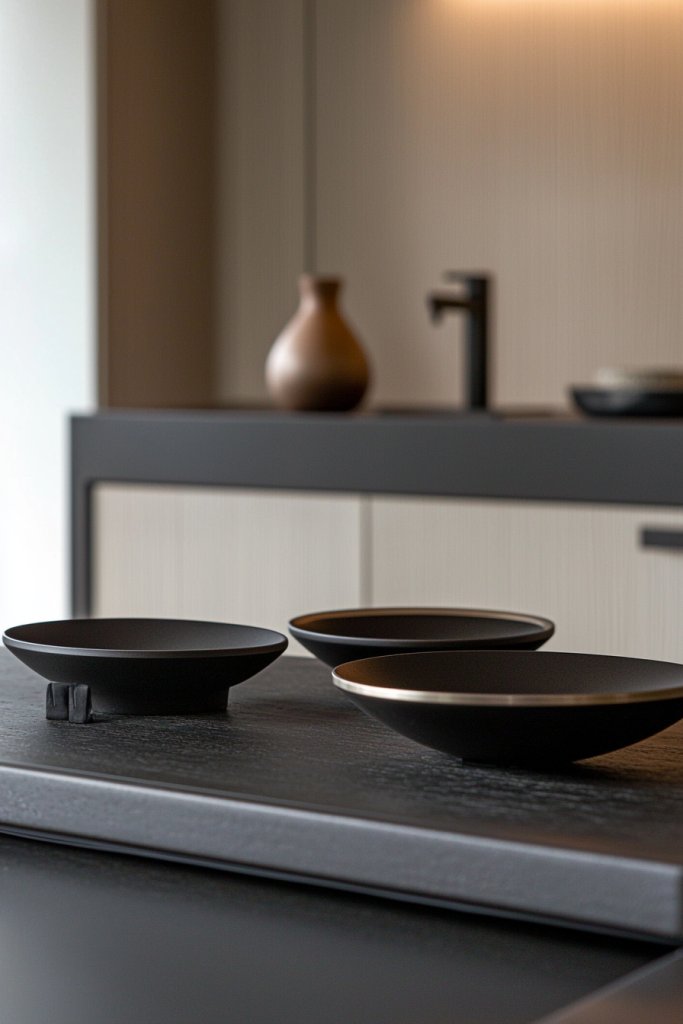
Incorporating delicate metallic touches introduces a refined layer of sophistication to the calm, minimalist aesthetic of Japandi interiors. These subtle accents—like matte black, brushed nickel, or antique brass—add depth and contrast without overwhelming the serene palette.
When used thoughtfully, metallic details elevate the overall design with a quiet elegance that complements natural textures. Picture a simple, low wooden coffee table with matte black metal legs or a set of minimalist ceramic bowls with brushed nickel rims.
Small metallic vases or candleholders placed on shelves or side tables subtly catch the eye, offering a touch of shine that enhances the understated aesthetic. These accents provide visual interest and a modern touch while maintaining the room’s peaceful, balanced vibe.
To incorporate these elements, choose a few key pieces—perhaps a sleek lamp with a brushed nickel finish or a set of black metal picture frames. Keep metallic accents minimal—avoid clutter—to preserve the room’s calm simplicity.
You can find affordable options at home decor stores or repurpose existing items by spray-painting or refinishing. The goal is to add just enough contrast to make the space feel polished and elegant, without compromising its tranquil essence.
14. Feature Functional Storage Solutions with a Minimalist Edge
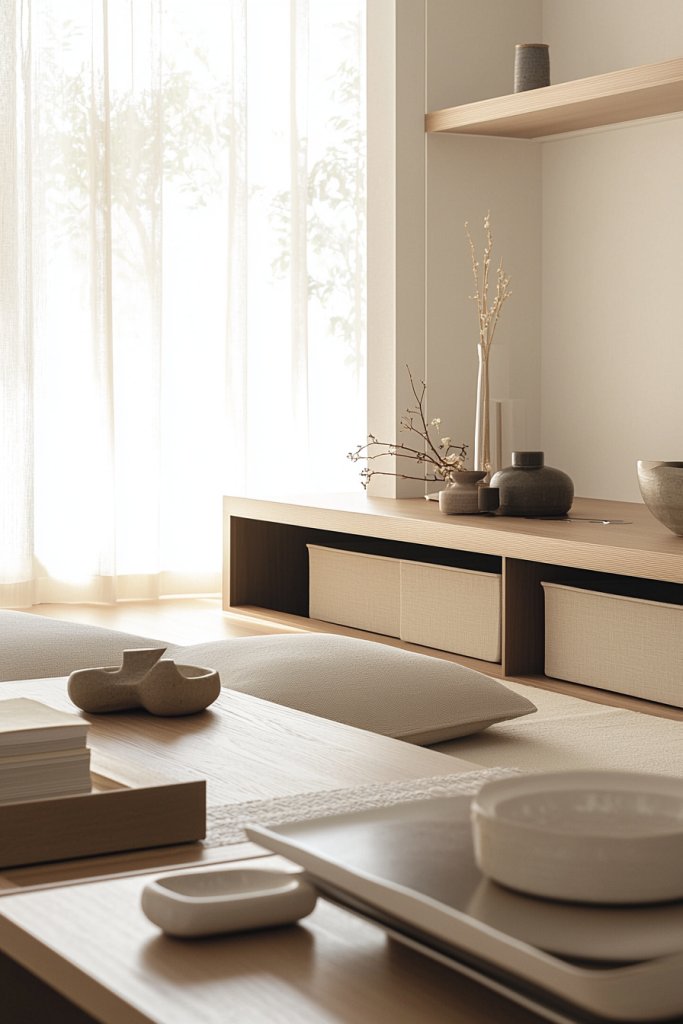
Clutter-free living is fundamental to Japandi style, making smart storage solutions a key component. Functional storage keeps your space tidy while blending seamlessly into the minimalist aesthetic.
The focus is on sleek, unobtrusive pieces that offer practicality without sacrificing design integrity. Envision a streamlined sideboard or low-profile shelving unit in natural wood or matte black, providing ample space to hide everyday items.
Incorporate discreet storage ottomans or woven baskets that can serve as both seating and storage, reducing visual clutter. Use furniture with built-in compartments to keep surfaces clear—think hidden drawers or cabinets that blend into the overall design.
To implement, select storage furniture that echoes the room’s simplicity—think flat-fronted cabinets or open shelving with clean lines. Opt for materials like light oak, bamboo, or matte finishes, which complement the natural and neutral palette.
Keep decorative objects to a minimum, reserving surfaces for only a few meaningful or functional pieces. These thoughtful storage solutions help maintain a calm, organized environment, making daily living more relaxing and stress-free.
15. Use Monochromatic or Tonal Decor for Cohesion

Achieving a peaceful, harmonious look in a Japandi living room often involves sticking to a monochromatic or tonal color scheme. This approach creates a seamless visual flow that soothes the eye and fosters a sense of unity.
By choosing decor elements within the same color family, you develop a cohesive, understated aesthetic that exudes calm and balance. Imagine a living room where shades of soft beige, warm grey, and muted taupe are woven throughout—cushions, throws, rugs, and decorative accessories all in subtle variations within this palette.
Textures become more noticeable and inviting when colors are consistent, such as a plush linen cushion paired with a textured wool rug or a matte ceramic vase. This tonal harmony makes the space feel more expansive and thoughtfully curated, enhancing its serene vibe.
To create this effect, select a core color—like warm grey—and build your decor around it. Mix different textures and materials—cotton, linen, ceramics, and wood—to add depth without introducing jarring contrasts.
Keep patterns minimal or subtle, focusing instead on the richness of textures and shades. This strategy simplifies decision-making and results in a tranquil, cohesive space that feels effortlessly balanced and timeless.
16. Incorporate Japanese-Inspired Shoji Screens or Partitions
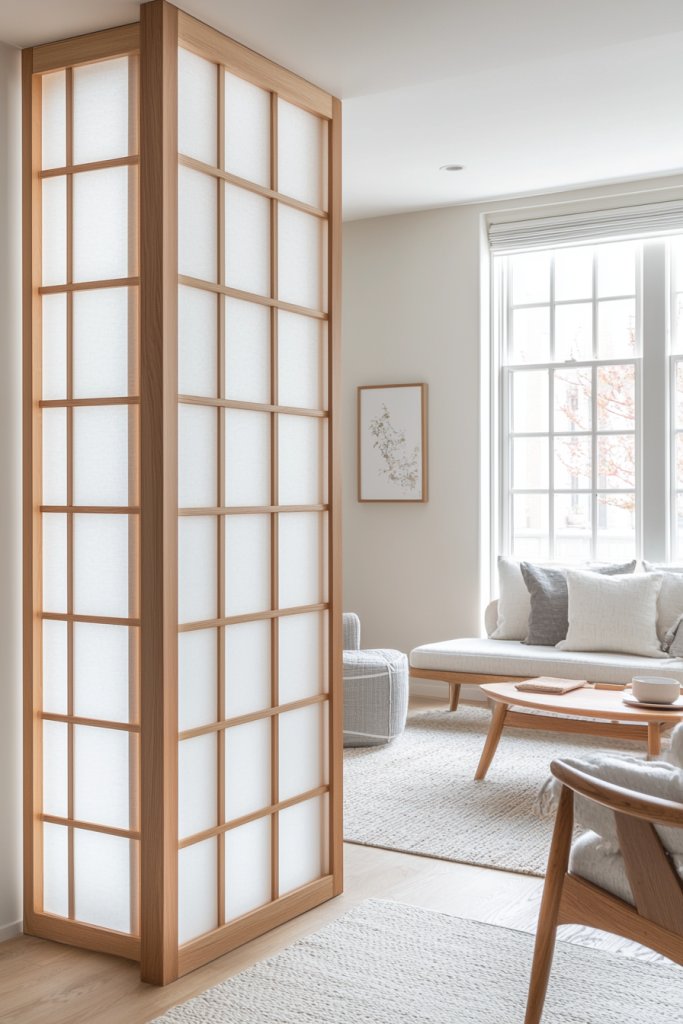
Adding Japanese-inspired shoji screens or partitions is a beautiful way to subtly define spaces within a Japandi living room while maintaining an airy, open feel. These screens are typically made from lightweight wood frames and translucent rice paper or frosted acrylic panels, creating a soft, diffused light that enhances the serene atmosphere.
Their minimalist design offers a refined, cultural touch that complements the clean lines and natural materials characteristic of Japandi style. Whether used to separate a seating area from a reading nook or to create a sense of privacy without closing off the space, shoji screens serve both functional and aesthetic purposes.
Visually, imagine a flat, rectangular panel with a delicate grid of thin, dark wood framing that contrasts beautifully with the muted wall colors. The panels emit a gentle glow when lit from behind, casting subtle shadows and adding depth.
The overall look is understated yet elegant, with the translucent material softening the natural light filtering through large windows. The screens can be customized in size and pattern—ranging from simple grids to more intricate geometric designs—allowing flexibility in various room layouts.
Their presence invites a calm, contemplative mood, echoing traditional Japanese interiors but adapted for modern living spaces. To incorporate shoji screens into your living room, start by selecting a lightweight wood frame—bamboo or birch work well—and choose a translucent panel material like frosted acrylic or rice paper.
You can find ready-made panels or DIY kits online. Place the screens strategically to define different zones or as decorative room dividers.
For a seamless look, opt for natural wood finishes or paint the frames in soft, matte tones that match your palette. Lightweight and easy to move, these screens are a simple, elegant way to add privacy and depth to your Japandi-inspired space.
17. Focus on Quality over Quantity in Decor Choices
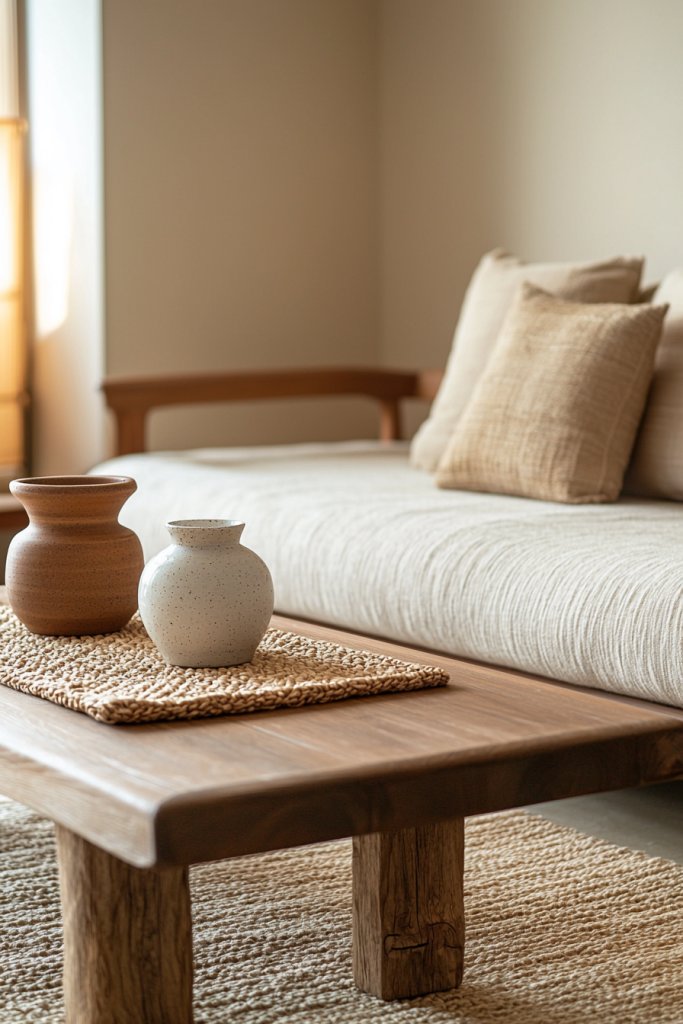
In the world of Japandi interiors, embracing quality over quantity is key to creating a peaceful, clutter-free living room. Instead of filling the space with numerous decorative objects, select a few well-made pieces that embody craftsmanship and timeless appeal.
Think of a single handcrafted ceramic vase with a matte finish or a sleek, minimalist sculpture that serves as a subtle focal point. Prioritizing quality ensures that each piece contributes meaningfully to the serene aesthetic, fostering a sense of calm and mindfulness.
Imagine walking into a room where each decor item has a story—an artisan-made stoneware bowl with organic textures, or a simple wooden tray with smooth, rounded edges. The textures and finishes of these pieces evoke warmth and durability, inviting touch and appreciation.
The color palette remains subdued—muted beige, charcoal, or soft taupe—allowing each item to stand out quietly. This approach encourages mindful purchasing, where each decor element is carefully curated for its longevity and visual harmony, rather than filling space with fleeting or trendy objects.
To achieve this, focus on investing in a handful of high-quality items rather than numerous cheaper alternatives. Seek out artisans or reputable brands that emphasize craftsmanship, sustainable materials, and timeless design.
Look for pieces that can serve multiple purposes—such as a ceramic bowl that doubles as a decorative object or a wooden box for storage. Incorporate these select pieces thoughtfully—placing them on a low console or open shelving—so they become part of a cohesive, calming environment. This minimalist philosophy fosters a peaceful sanctuary that values durability, beauty, and intentional living.
Conclusion
With these 17 Japandi living room ideas, you have a versatile blueprint to create a serene, stylish space that balances simplicity and warmth. From neutral palettes and natural materials to thoughtful furniture placement and subtle decor accents, each element works together to foster calm and harmony.
Feel empowered to incorporate these concepts into your own home, transforming your living room into a peaceful retreat. Embrace the mindful elegance of Japandi and let your space reflect tranquility and refined taste.
Leave a Reply